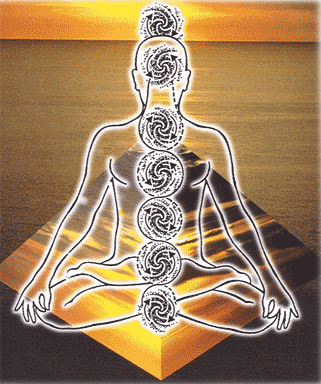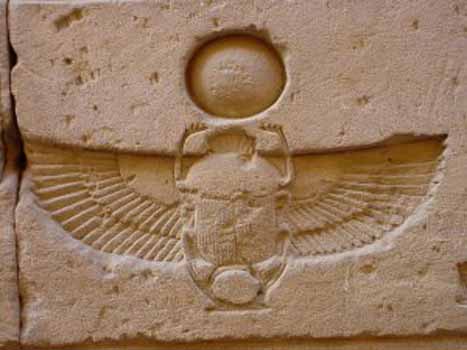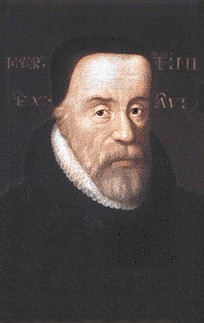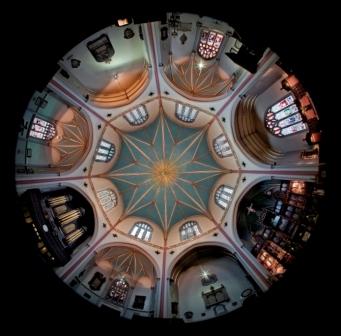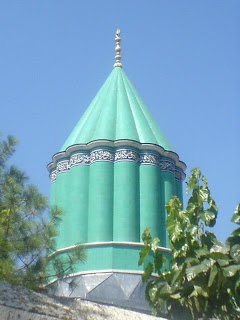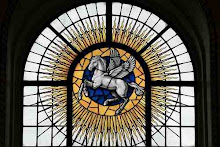
"God is light, and in him is no darkness at all. If we say that we have fellowship with him, and walk in the darkness, we lie, and do not the truth: but if we walk in the light as he is in the light, we have fellowship with one another, and the blood of Jesus Christ his Son cleanseth us from sin." - First Epistle of John
For the Cathars, Jesus Christ was made up of pure Spirit and had no material form. As an emissary from the True God he could contain no element of the corrupt Creation of Satan and thus only had the appearance of a physical form. This wholly spiritual Christ was utterly incomprehensible to the Church, for whom the notion of Christ's Resurrection in the flesh was the whole essence of the Christian message. Since Tertullian's insistence that physical Resurrection was what was taught in the Gospels and the Epistles, the idea that our material forms would reemerge in Judgement Day had been a central plank of Catholic Theology. Indeed, the physical humanity of Christ coupled with his Divine Nature was a key element in what his Mission on Earth meant to Christians from Rome to Constantinople. It still is today. For the Cathars, however, this was a deception propagated by the Devil as part of his desire to destroy our awareness of our Christ-like Nature. As the Son, Jesus was sent by God to show us the way to return to the Light Realms of pure Spirit. As human mortality was a result of Satan's Creation, the Son of God could not be confined by the taint of Matter. As John's Gospel says:
“God is a Spirit: and they that worship him must worship him in spirit and in truth”
This vision of a purely spiritual Christ drew accusations of Docetism from the Church and was derided as meaning that Christ was no more than a phantom. But in fact the implications of this view of the Cathars are rather more interesting. Firstly, by identifying Christ as a spiritual being, they were able to release him from his historical aspect, something which has fixated the Church for millenia. Thus Christ ceased to be confined by Space and Time but became a Universal Being , present beyond those boundaries. Thus in contrast to much of Church theology outside a few Mystics, the Cathars believed in Christ in his Cosmic aspect as opposed to a person who lived and died in 1st Century Judea. Secondly, by describing Christ in this way the Cathars were making a profound point about the nature of Divine Humanity - that in essence Christ was an image of our Angelic Nature ie that in reality we were all Christs, or potentially Christs, just as the Gnostic Gospel of Philip says. Christ's preeminance as the Son, an expression of God, set him above us all but his appearance and his Path presented the possibility of us all regaining our Angelic Nature in Light. Thus the Crucifixion was not the focus of the Gospel Story for the Cathars, rather the entire span of Christ's life as described therein - Birth, Baptism, Transfiguration, Glorification, Crucifixion, Death, Resurrection, Ascension and ultimate return to the Father. Thus Eternal Life in Jesus Christ was interpreted as release from the cycle of Reincarnation and reunion with God:
"For God so loved the world, that he gave his only begotten Son, that whosoever believeth in him should not perish, but be given everlasting life. For God sent not his Son into the world to condemn the world; but that the world through him might be saved."

It was this hostility to the Crucifixion as the iconic event in Christ's life that was especially abhorrent to the Church as it involved open preaching on behalf of the Cathars against the Cross as a symbol of the Son. As pretty much everyone knows, the Cross has been the central sacred image for Christians before and after the Cathars, embodying the ultimate sacrifice Christ underwent to save humanity from Sin. For the Cathars, though, it was a symbol of suffering, torture and pain and thus a slander upon Christ. One Parfait is recorded as saying that a man should smash a Crucifix 'as a father would smash the gallows upon which his son was hanged'. As a piece of Matter, it was doubly part of Satan's realm and worship of it was particularly idolatrous. Understandably, the Church viewed such polemic as deeply sacreligious and accused the Cathars of all manner of desecration of sacred sites.
So Christ's story was an embodiment of the Way. By following him, by walking in his footsteps, humanity could be transformed as he was transformed. The key part of this process for the Cathars, was the action of the Holy Spirit, released into this world by Christ and passed down to the Parfaits by an unbroken chain of links from the Apostles. It was here, in the transformative agency of the Holy Spirit conveyed through the laying on of hands in the ritual known as the Consolamentum, that the heart of Cathar spirituality lay. It was also where its fundamentally different focus to the Church appeared. For where Catholicism laid the ultimate importance upon the Cruficixion, Catharism looked towards the Holy Spirit as the key. Christ had shown the way, but his legacy was the Holy Spirit, a gift or 'charism' given to the human race to enable it to realise its Divine Humanity. What Christ had told the Apostles at the Last Supper was still true for the Cathars. The Holy Spirit was the ultimate expression of God's love for mankind:
“And I will pray the Father, and he shall give you another Comforter, that he may abide with you for ever; Even the Spirit of truth, whom the world cannot receive because it seeth him not, neither knoweth him: but ye know him; for he dwelleth with you, and shall be in you”
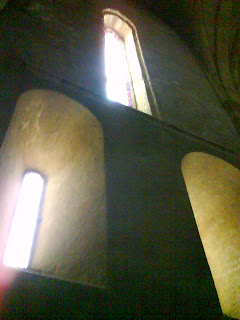 This was their purpose - to spread the power of the Holy Spirit among all humanity, restoring them to their Angelic State as Christ had done. Once the Parfait had been inducted into the elite, he or she (for the Cathars recognised the equal value of women in the Divine Mystery) would go among the Croyants, ministering to them, and wherever else, spreading the Cathar faith. In keeping with their claim of Apostolic Succession and belief in the minutiae of Christ's instructions, they travelled as the Apostles are described as doing in the Gospels - in twos with nothing more the bare necessities on their back: a copy of the Bible, a few provisions etc. To avoid sexual temptation they always travelled with a companion of the same sex, a practise which drew accusations of homosexuality from their enemies. Also as described in the Gospels, they relied on the hospitality of the Croyants for their accomodation. Cathar families vied to house wandering Parfaits, viewing as a great honour. In return, the Parfaits would hold services in their homes and tend to the sick if it was so needed. Where someone was dying, the Consolamentum would be carried out, the belief being that the purification of the Holy Spirit at the hour of death would enable the Soul of the dead to return in an incarnation one step closer to Perfection. Again, all these practises - the mendicant lifestyle, the focus upon the state of the Soul at death before reincarnation etc - show parallels with those of the Buddhists and Hindus of the East...
This was their purpose - to spread the power of the Holy Spirit among all humanity, restoring them to their Angelic State as Christ had done. Once the Parfait had been inducted into the elite, he or she (for the Cathars recognised the equal value of women in the Divine Mystery) would go among the Croyants, ministering to them, and wherever else, spreading the Cathar faith. In keeping with their claim of Apostolic Succession and belief in the minutiae of Christ's instructions, they travelled as the Apostles are described as doing in the Gospels - in twos with nothing more the bare necessities on their back: a copy of the Bible, a few provisions etc. To avoid sexual temptation they always travelled with a companion of the same sex, a practise which drew accusations of homosexuality from their enemies. Also as described in the Gospels, they relied on the hospitality of the Croyants for their accomodation. Cathar families vied to house wandering Parfaits, viewing as a great honour. In return, the Parfaits would hold services in their homes and tend to the sick if it was so needed. Where someone was dying, the Consolamentum would be carried out, the belief being that the purification of the Holy Spirit at the hour of death would enable the Soul of the dead to return in an incarnation one step closer to Perfection. Again, all these practises - the mendicant lifestyle, the focus upon the state of the Soul at death before reincarnation etc - show parallels with those of the Buddhists and Hindus of the East...Fascinatingly, this Cathar return to the Apostolic ideal helped lead to the founding of the Dominican and Franciscan Orders in the Church. For faced with the humbleness and poverty of the Parfaits, the riches and finery of the Church served only to demonstrate how far the it had fallen from the Christian ideal. It was St Dominic who told the then Pope that, were the Cathars to be defeated spiritually, they had to be faced on their own terms. Hence the Mendicant Order of St Dominic was founded and the appearance of Francis of Assisi in Rome was viewed kindly. Legend has it that the Pope was about to declare Francis a heretic when a prophetic dream made him change his mind. Realising that Francis' vision represented an important return to the purity of Christ's ideals, he decided to allow him to found his own Order. Ironically, as the Dominican-led Inquisition set in to combat the Cathars, it was the Franciscans who often lead the opposition. Indeed, after the demise of the Cathar faith, it is believed that a lot of Parfaits joined the ranks of the Poor Brothers as the one way they could remain true to their beliefs...













